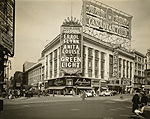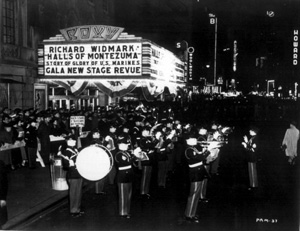

I have always loved watching movies, but there is something about going to a movie theater that completely overtakes me. Have I been there before, if so what screen was I sitting at, do I know anything about this theater (how many screens, when was it built, what kind of movies play there)? And this is just the buildup, the actual movie going experience absorbs me; what type of refreshments would benefit this experience the most, how will seeing the movie in one seat differ from another, what type of sound system is installed, is this projection digital or reel based? To put it more simply, I get excited watching movies in theaters because of the entire experience behind the process. And now that I am documenting the movie theaters in the city, specifically Union Square, for this class I will finally get a chance to learn the real story behind these theaters rather than the one I created in my head from viewing experiences.
I made my way to the NYU Bobst library this morning from my apartment on 12th Street and 1st Avenue wondering about my project for class. I had eight call numbers looked up and was eager to explore the vast unknown of movie theaters in the Union Square area throughout history. Making my way from street to street I began looking up to see some of the structures surrounding me and imagined hidden movie theaters within these walls now masked with facades of post-modernity. In a city with so many possibilities for redevelopment I was getting excited, the story behind these movie theaters could lead me anywhere and I was going to make this process a journey.
I knew there was a lot of ground to cover, and the subject matter was very broad to seek out books as sources of information, but I was convinced that looking at the first movie theaters in Manhattan was the best place to start this process. I learned about the movie palaces that Thomas Lamb created along Broadway through the early 1900’s, The Roxy theater that brought Times Square to its knees when it opened in 1927, and the Regent which was the first big movie palace in the city when it opened in 1913 and was almost demolished in the 1970’s until it was registered as a historical monument and now functions as the First Corinthian Baptist Church. The only problem with all of this information was that it didn’t discuss anything related to the Union Square area. After a lot of searching I did find one theater from this era that was close enough to Union Square to be included in the project, the now abandoned Lowes Canal Theater. Located at 31 Canal Street at the corner of Ludlow, it was one of Thomas Lamb’s creations that would expand the movie palace to lower Manhattan with a 2,379 seat venue. The only problem with this theater is that I could not locate a photo of the actual theater, but the structure still stands and the façade is a registered historic landmark so the building won’t be disappearing. There is also a fundraiser underway towards raising enough money to convert the abandoned theater into a multi-purpose performing arts center. This would be a great start for this project, but that information is all I could obtain from the books on my original bibliography and an online search. And after a half day skimming pages for historic movie theaters near Union Square I could only find one to start talking about. There is such a wealth of information in these theaters from the architects that made a living by designing them to the ushers that created their own language to communicate with one another. However, all of this falls short of my original project.
A number of problems occurred throughout this process that I will slowly have to change my outlook on. Unfortunately there is no one book on the history of movie theaters in New York, although there are a number of edited books on specific theaters throughout the country, and the few books that discuss movie theaters in Manhattan rarely include address information or maps to compliment the material provided. The bulk of these books are organized chronologically and cover movie theaters around the country. I guess this is where my project comes in, but there are still a lot of theaters which were documented with photos and text yet no address or cross street was included such as the Times Square Paramount. Even search words are causing problems because the topics are too broad such as movie theater, film exhibition, movie palaces, theater history, New York film, and cinema studies. There is just too much related to these words that are not relevant to the project and I have yet to find a true word or word combination that epitomizes what I am trying to do. Again, maybe this is something my project can remedy.
I think I just hit a wall today with my library research and need to expand to magazine and newspaper archives as well as online research. I would love to expand the project to include some of this information I recovered today, but until I can figure out exactly what I am looking for I think limiting this project to the Union Square area is the best approach for the time being.
Hi, Matt. This is the point of original research: we’re bringing together secondary and primary resources to carve out a unique area of research. It’s very rare that you’d find “one book on the history of movie theaters in New York” — and if you did find that book, you’d have to wonder what point there is in *your* undertaking the same research. You mention that “there are still a lot of theaters which were documented with photos and text yet no address or cross street”; this is again where you have to cross-reference resources to find what you’re looking for. You might find addresses for some of these old theaters in various city departments’ archives: http://www.nyc.gov/html/lpc/html/faqs/research_resource.shtml
And if you find that Union Square alone doesn’t yield you enough material, you have to “scale up” your research area. Maybe choose a new sampling technique.
“I would love to expand the project to include some of this information I recovered today.” You can — and should — include some of the material you discovered in published theoretical and historical texts, regardless of whether or not you expand your project. This published material helps to provide the “argument” — the theoretical and historical context, the relevant socio-economic and political issues, etc. — for your own narrowly defined project. So, even if the books you read don’t speak *directly* to your specific interest, you need to be able to think abstractly enough to appreciate how these publications address bigger, more macro-scale issues that are germane to your project.